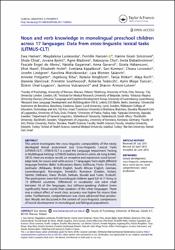| dc.contributor.author | Haman, Ewa | |
| dc.contributor.author | Luniewska, Magdalena | |
| dc.contributor.author | Hansen, Pernille | |
| dc.contributor.author | Simonsen, Hanne Gram | |
| dc.contributor.author | Chiat, Shula | |
| dc.contributor.author | Bjekic, Jovana | |
| dc.contributor.author | Vuksanovic, Jasmina | |
| dc.date.accessioned | 2019-10-22T20:06:52Z | |
| dc.date.available | 2019-10-22T20:06:52Z | |
| dc.date.issued | 2017 | |
| dc.identifier.issn | 0269-9206 | |
| dc.identifier.issn | 1464-5076 | |
| dc.identifier.uri | https://dx.doi.org/10.1080/02699206.2017.1308553 | |
| dc.identifier.uri | https://hdl.handle.net/11421/22090 | |
| dc.description | 13th International Congress for the Study of Child Language -- JUL, 2014 -- Amsterdam, NETHERLANDS | en_US |
| dc.description | WOS: 000415973600002 | en_US |
| dc.description | PubMed ID: 28441085 | en_US |
| dc.description.abstract | This article investigates the cross-linguistic comparability of the newly developed lexical assessment tool Cross-linguistic Lexical Tasks (LITMUS-CLT). LITMUS-CLT is a part the Language Impairment Testing in Multilingual Settings (LITMUS) battery (Armon-Lotem, de Jong & Meir, 2015). Here we analyse results on receptive and expressive word knowledge tasks for nouns and verbs across 17 languages from eight different language families: Baltic (Lithuanian), Bantu (isiXhosa), Finnic (Finnish), Germanic (Afrikaans, British English, South African English, German, Luxembourgish, Norwegian, Swedish), Romance (Catalan, Italian), Semitic (Hebrew), Slavic (Polish, Serbian, Slovak) and Turkic (Turkish). The participants were 639 monolingual children aged 3;0-6;11 living in 15 different countries. Differences in vocabulary size were small between 16 of the languages; but isiXhosa-speaking children knew significantly fewer words than speakers of the other languages. There was a robust effect of word class: accuracy was higher for nouns than verbs. Furthermore, comprehension was more advanced than production. Results are discussed in the context of cross-linguistic comparisons of lexical development in monolingual and bilingual populations. | en_US |
| dc.description.sponsorship | Berliner Senate and Bundesministerium fur Bildung und Forschung (BMBF), Germany [01UG1411]; Research Council of Norway through its Centres of Excellence funding scheme [223265]; National Science Centre, Poland [809/N-COST/2010/0]; Polish Ministry of Science and Higher Education [0046/DIA/2013/42]; Faculty of Psychology, University of Warsaw [BST2015-1744/4]; Ministry for Education, Science and Technological Development of Republic of Serbia [175012]; Slovak Research and Development Agency [APVV-0410-11]; Harry Crossley Foundation; National Research Foundation of South Africa [88631]; Ministerio de Economia y Competitividad, Spain [FFI2014-56968-C4-1-P]; Ake Wiberg Foundation [H14-0104]; Birgit and Gad Rausing Foundation (Sweden) [S14-14]; International Visegrad Fund [21420015] | en_US |
| dc.description.sponsorship | The research presented here was partially supported by Berliner Senate and Bundesministerium fur Bildung und Forschung (BMBF), Germany [grant number 01UG1411]; the Research Council of Norway through its Centres of Excellence funding scheme [grant number 223265]; the National Science Centre, Poland [grant number 809/N-COST/2010/0]; Polish Ministry of Science and Higher Education [grant number 0046/DIA/2013/42]; Faculty of Psychology, University of Warsaw [grant number BST2015-1744/4]; Ministry for Education, Science and Technological Development of Republic of Serbia [grant number 175012]; the Slovak Research and Development Agency [grant number APVV-0410-11]; Harry Crossley Foundation and National Research Foundation of South Africa [grant number 88631]; Ministerio de Economia y Competitividad, Spain [grant number FFI2014-56968-C4-1-P]; and Ake Wiberg Foundation [grant number H14-0104], Birgit and Gad Rausing Foundation (Sweden) [grant number S14-14]. We also acknowledge support from International Visegrad Fund partially enhancing collaboration reported in this article [grant number 21420015]. All pictures used for CLTs are subject of copyright of University of Warsaw (Poland). | en_US |
| dc.language.iso | eng | en_US |
| dc.publisher | Taylor & Francis Inc | en_US |
| dc.relation.isversionof | 10.1080/02699206.2017.1308553 | en_US |
| dc.rights | info:eu-repo/semantics/openAccess | en_US |
| dc.subject | Lexical Development | en_US |
| dc.subject | Cross-Linguistic Comparison | en_US |
| dc.subject | Basic Word Classes | en_US |
| dc.subject | Word Comprehension | en_US |
| dc.subject | Word Production | en_US |
| dc.title | Noun and verb knowledge in monolingual preschool children across 17 languages: Data from Cross-linguistic Lexical Tasks (LITMUS-CLT) | en_US |
| dc.type | conferenceObject | en_US |
| dc.relation.journal | Clinical Linguistics & Phonetics | en_US |
| dc.contributor.department | Anadolu Üniversitesi, Sağlık Bilimleri Fakültesi | en_US |
| dc.identifier.volume | 31 | en_US |
| dc.identifier.issue | 11.Ara | en_US |
| dc.identifier.startpage | 818 | en_US |
| dc.identifier.endpage | 843 | en_US |
| dc.relation.publicationcategory | Konferans Öğesi - Uluslararası - Kurum Öğretim Elemanı | en_US] |


















